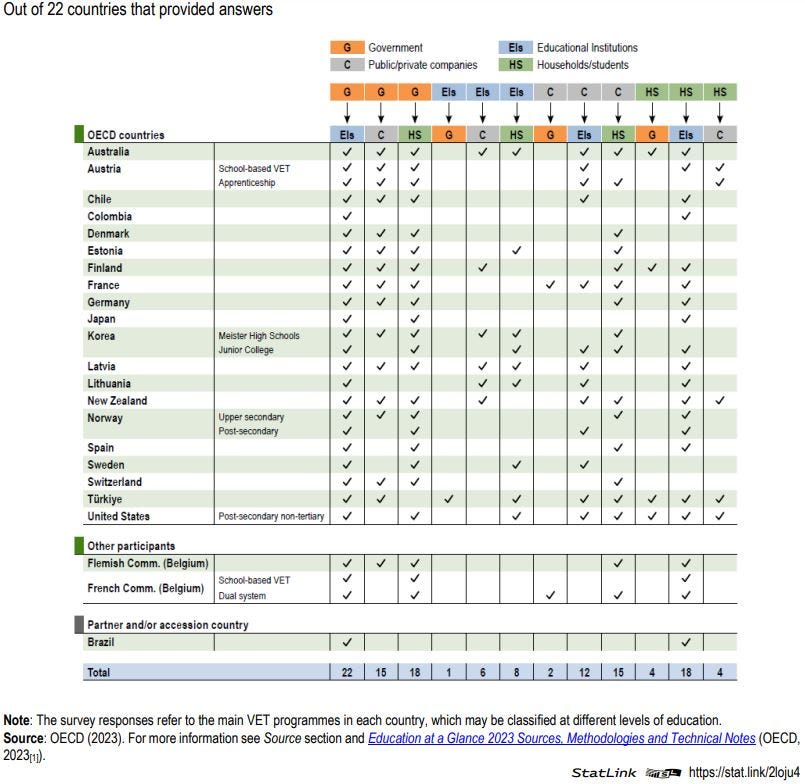Companies can play a crucial role in delivering VET by providing work-based learning, such as apprenticeships and internships. Integrating classroom teachings with practical work experience bridges the gap between theory and application. By integrating practice-oriented training within work environments, the financial burden of schooling can be alleviated, as equipment is often costly and can quickly become obsolete. Students can also learn from experienced colleagues in the workplace, reducing teacher costs within schools. The use of work-based learning, and therefore extent to which such cost-sharing occurs in VET varies across countries.
Public and private stakeholder funding for education
Education systems involve a variety of public stakeholders, such as central or local government, and private stakeholders, like students and companies. They invest into education and reap benefits in different ways. Education brings advantages, like reduced poverty, to society as a whole. It also brings specific benefits to individuals, such as higher wages, or advantages for companies that have invested into education, such as better productivity.

Key messages
Governments in many countries seek to encourage companies to provide work-based learning. Data are available on financial transfers to companies, such as subsidies provided to companies that host apprentices. Training levies, which require companies to collectively contribute to the funding of VET, can also aim to promote work-based learning. Denmark introduced a "target training ratio" per skilled employee, with companies that meet their target receiving an additional subsidy. This bonus is funded by contributions from companies that fall short of their target.
Financial incentives to promote work-based learning vary widely, both in terms of costs involved and underlying rationales. In Australia, Austria and France both universal and targeted incentives exist, such as additional subsidies for apprentices with a disability. Switzerland has a large apprenticeship system without universal subsidies, although some professional sectors have established a training levy. The Norwegian model is based on the idea that companies bear the burden of educating young people and therefore receive the equivalent of the cost of one year of school-based education and training.
Context
Government transfers to the private sector
This chart shows transfers to households, as well as transfers to “other private entities” – mainly companies - in the context of VET. Such transfers are substantial in various countries – in Norway nearly USD 2800 per student - reflecting generous subsidies provided to companies that host apprentices. In Greece, the United Kingdom and Norway, more than half of government transfers to the private sector are dedicated to companies.
Financial transfers to support vocational education and training programs
Governments make transfers to schools, households and companies in most countries. Educational institutions mostly only receive transfers, with a few exceptions where they make transfers (e.g. in Lithuania they cover some costs of apprentice wages). Companies sometimes transfer funds to cover costs within educational institutions (e.g. Australia, New Zealand) or provide generic funding for a programme (e.g. Austria, Latvia, Lithuania).
Financial transfers to support vocational education and training programmes (2023)

Related publications
-
 20 December 2023
20 December 2023 -
 Policy paper12 October 2023
Policy paper12 October 2023
Programmes and projects
-
The OECD Indicators of Education Systems (INES) programme seeks to gauge the performance of national education systems through internationally comparable data.Learn more
-
The OECD’s programme on education and skills policy support policymakers in their efforts to achieve high-quality lifelong learning, which in turn contributes to personal development, sustainable economic growth, and social cohesion.Learn more
-
PISA is the OECD's Programme for International Student Assessment. PISA measures 15-year-olds’ ability to use their reading, mathematics and science knowledge and skills to meet real-life challenges.Learn more
-
Since 2013, the OECD has gathered evidence on how school resource policies work in different contexts. The focus is now on digital resources to enable countries to learn from each other in the digital transformation of their education.Learn more
-
Data and digital technologies are among the most powerful drivers of innovation in education, offering a broad range of opportunities for system and school management, as well as for teaching and learning. But they also create new policy issues as countries face challenges to reap the benefits of digitalisation in education while minimising its risks.Learn more
-
TALIS - the Teaching and Learning International Survey - is the world's largest international survey about teachers and school leaders.Learn more




